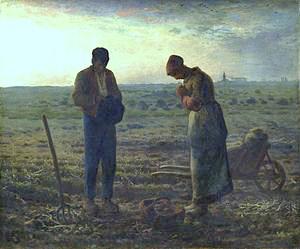When I was about nine years old, a certain picture made a huge impression on me. As I grew older, this picture came into my life over and over. When I married in 1978, my wife bought the print for me, and I have prominently displayed and enjoyed it ever since.
The original oil on canvas was painted by Jean-Francis Millet, a Frenchman who lived from 1814-1874. From1858 to 1859, Millet painted his masterpiece and titled it “The Angelus.” This inspiring painting is rather simple: Imagine a furrowed field with a humble husband and wife standing together, heads bowed in prayer, next to a simple barrow-plow carrying a sack of seed, and faintly in the distance, a small country church. I often considered how they understood the miracle of life within the seed — just part of the recipe for an abundant crop.
Without the warmth of the sun and the refreshing of the rain, the seasons, the nutrient richness of the soil — and the hand of God requested by a faithful man and woman — a seed is just a seed. But, coupled with the reverence of faithful men and women invoking the bountiful blessings of a loving heavenly Father, that seed once planted and watered begins to bring forth beneficial life, and is nurtured until the time of harvest when the resulting crop is used for the service of man and animal. The best seed was first given to the church as a tithe, some saved for the next planting, and the rest (plus the remaining plant parts) used for food and other beneficial purposes. This cycle of giving and receiving makes for great abundance.
As we look closer, we realize plants do not self-produce much needed minerals. Instead they extract and transfer them from the soil to the plant to benefit man and animal, it is not long before soil becomes deficient. As stewards of the land, man learned to replenish the soil nutrients using a myriad of methods. For thousands of years, man added nutrient rich wood ash to the soils, brought in minerals from other areas, and amended soils with decayed plant and/or animal matter. This continued for centuries.
However, within recent decades and the rise of commercial farms, these methods of replenishing vital minerals have curtailed. In pursuit of profits, modern farm practices replenish only what is required for plant growth (N-P-K) at the exclusion of mineral nutrients required by people and animals. As formerly mineral-rich foods have become deficient, so has our health. We hear unending reports of cancer, strange diseases, diminished quality of life, mental imbalances, decreasing longevity, and other maladies that did not prevail just a few generations ago. As the minerals have been systematically removed from the food supply, these maladies have become commonplace.
Dr. Joel D. Wallach of The Center for the Biology of Natural Systems wrote in 1968, “Every animal and every human being that dies of natural causes dies of a nutritional deficiency disease.” To the degree your body is mineralized and nutrified, you enjoy strength, vitality, and health. Becoming nutritionally depleted invites sickness and weakness.
You must be proactive in reversing your mineral and nutritional deficiencies. Because soil supplementation and growing your own food takes time, it is imperative that you change and implement the following lifestyle practices.
Following are tips on how to do that:
- Supplement your body with high quality vitamins, minerals, and enzymes
- Invest in a quality water filter
- Start your own or a cooperative neighborhood garden • Replenish soil nutrients which produce nutrient rich foods
- Thank your Heavenly Father for blessing the “good seed”
About the author: Gary Lochte and his wife Judy live on the land of Medina County, Texas. Gary has developed a unique and sensible approach to natural health, nutrition, animal husbandry, and natural gardening.

